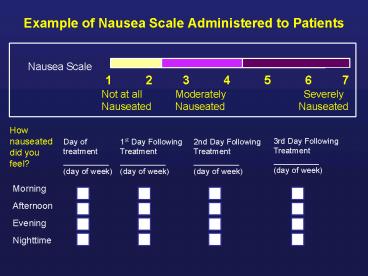Example of Nausea Scale Administered to Patients - PowerPoint PPT Presentation
1 / 12
Title:
Example of Nausea Scale Administered to Patients
Description:
vomiting on the day of treatment. ... Palonosetron is the preferred 5-HT3 RA in HEC. For more information see: http://www.nccn.org. ... – PowerPoint PPT presentation
Number of Views:76
Avg rating:3.0/5.0
Title: Example of Nausea Scale Administered to Patients
1
Example of Nausea Scale Administered to Patients
Nausea Scale
1 2 3 4 5
6 7
Not at allNauseated
ModeratelyNauseated
SeverelyNauseated
Hownauseateddid youfeel?
3rd Day FollowingTreatment __________ (day of
week)
Day oftreatment __________ (day of week)
1st Day FollowingTreatment __________ (day of
week)
2nd Day FollowingTreatment __________ (day of
week)
Morning Afternoon Evening Nighttime
2
Results of Multicenter Study on Incidence of
Nausea Associated With 3 Chemotherapeutic Agents
Cisplatin Carboplatin
Doxorubicin
7.5
2.8
17.0
18.9
4.3
22.5
Acute
78.7
89.7
58.6
10.4
19.1
40.8
42.6
25.4
24.5
Delayed
38.3
65.1
33.7
Nausea
Mild or none Moderate Severe
Adapted from Hickok JT, Morrow GR, Roscoe JA,
Pierce HI, Rosenbluth RJ. Prevalence and severity
of acute and delayed nausea and vomiting
associated with three highly emetogenic
chemotherapies. A URCC CCOP Multicenter Study.
3
Results of Multicenter Study on Incidence of
Vomiting Associated With 3 Chemotherapeutic Agents
Cisplatin Carboplatin
Doxorubicin
2.8
11.6
16.6
Acute
78.7
88.4
97.2
83.4
22.6
24.3
Delayed
34.0
66.0
77.4
75.7
Occurrence of Vomiting
Yes No
Adapted from Hickok JT, Morrow GR, Roscoe JA,
Pierce HI, Rosenbluth RJ. Prevalence and severity
of acute and delayed nausea and vomiting
associated with three highly emetogenic
chemotherapies. A URCC CCOP Multicenter Study.
4
Comparison of the 3 Chemotherapeutic Agents
Doxorubicin was associated with greater nausea
in both the acute and delayed phases of
treatment than either Cisplatin or
Carboplatin. Cisplatin was most likely to
cause delayed vomiting. Doxorubicin was most
likely to be associated with vomiting on the
day of treatment.
Adapted from Hickok JT, Morrow GR, Roscoe JA,
Pierce HI, Rosenbluth RJ. Prevalence and severity
of acute and delayed nausea and vomiting
associated with three highly emetogenic
chemotherapies. A URCC CCOP Multicenter Study.
5
Risk Factors for Chemotherapy-related Emesis
Treatment-related risk factors High
emetogenicity of chemotherapy drugs High drug
dose Patient-related risk factors Younger
age Female gender No/minimal history of
alcohol use Susceptibility to motion sickness
Poor control with prior chemotherapy
Adapted from Gralla RJ, et al. J Clin Oncol.
1999172971-2994.
6
Neurotransmitters Involved in Emesis
Dopamine, serotonin, and substance P receptors
are particularly associated with
chemotherapy-induced symptoms.
GABAgamma aminobutyric acid.
7
Chemical Structures of Palonosetron and Other
5-HT3 Receptor Antagonists
First-generation 5-HT3 antagonists resemble
serotonin. Palonosetron is structurally
distinct.
8
Patients Undergoing Chemotherapy Rank Severe CINV
as Near Death
Moderate Delayed Nausea
Poorly Controlled Acute Delayed CINV
Median VAS Scores
Complete Control
Death
Mucositis
Remission
Perfect Health
Weight Gain
Memory loss
Taste Change
Thrombocytopenia
CINV 1
Current Health
Alopecia
Depression
Ototoxicity
Sexual Dysfunction
Constipation
Leg pain
Fatigue
Flu
Peripheral Neuropathy
Diarrhea
Dysuria
CINV 4
CINV 6
CINV 5
Death
CINV 2
Mucositis
CINV 3
Febrile Neutropenia
Sun C et al. Support Care Cancer. 200513219-227.
9
1st Generation 5-HT3 RAs Are Therapeutically
Equivalent
- Pts receiving MEC (N1,085)
- Highest Level Evidence
- Not Debated
- MASCC 2004
- NCCN 2009
- ASCO 2006
- 1st Generation Agents are
- Therapeutically Equivalent
- Dolasetron
- Ondansetron
- Granisetron
- 1st Generation oral and IV
- doses equally effective
Oral granisetron 2 mg
IV ondansetron 32 mg
72.0
71.0
60.0
59.0
58.0
58.0
Complete Control ()
Total
Nausea
Emesis
80 of pts received prophylactic
steroids Cyclophosphamide 5001200 mg/m2,
carboplatin 300 mg/m2 Perez et al. J Clin Oncol
199816754
10
Palonosetron Dexamethasone vs Ondansetron
Dexamethasone in HEC Complete Response
100
Palonosetron 0.25 mg IV (n150)
Plt.025 (Fishers exact test)
Ondansetron 32 mg IV (n147)
80
64.7
Complete Response(No Emesis, No Rescue) ( of
Patients)
55.8
60
42.0
40.7
40
28.6
25.2
20
0
Acute 0-24(Day 1)
Delayed 24-120(Days 2-5)
Overall 0-120(Days 1-5)
Time (hr)
- 51 female mean age 53 years 61
chemotherapy-naïve - Majority of patients receiving cisplatin HEC
Aapro M et al. Ann Oncol. 2006 171441-1449
Natale J, Cartmell A. ASHP Midyear Clin Meeting.
2005. Abstract P-690(E).
11
NCCN V.4.2009 Antiemesis Clinical Practice
Guidelines Palonosetron is the preferred 5-HT3
RA in HEC
Aprepitant PO (or fosaprepitant) in select
patients Dexamethasone PO/IV and 5-HT3
antagonist Palonosetron 0.25 IV or Ondansetron
or Granisetron or Dolasetron or and ?
Lorazepam
Aprepitant (Days 2-3) if used on Day 1
and Dexamethasone PO/ IV daily
or Dexamethasone or 5-HT3 antagonist
Ondansetron or Granisetron or Dolasetron
?Lorazepam
Aprepitant (or fosaprepitant) day 1 Aprepitant
PO Days 2-3 Dexamethasone PO/ IV daily Days
2-4 and 5-HT3 antagonist Palonosetron 0.25 mg
day 1 (preferred category B) Ondansetron Day
1 or Granisetron Day 1 or Dolasetron or Day 1
or and ? Lorazepam Days 1-4
NCCNNational Comprehensive Cancer Network.
For more information see http//www.nccn.org.
Saito M, Aogi K, Sekine I et al. Lancet Oncol.
2009 10115-124
12
Second-generation 5-HT3 Receptor Antagonist
Palonosetron Demonstrated Higher Complete
Response Than First-generation Agents
Mean age 55 years 54 chemotherapy-naive
Majority women receiving cyclophosphamide and/or
doxorubicin combination MEC Concomitant
dexamethasome pretreatment received by 2.5 of
patients Breast cancer (63) most common
diagnosis, followed by lung cancer
(8) IVintravenous MECmoderately emetogenic
chemotherapy.































